|
FAQs about the Diseases
of Clownfishes
24
Related FAQs: Clownfish Disease 1, Diseases of Clownfishes 2, Diseases of Clownfishes 3, Clownfish Disease 4, Clownfish Disease 5, Clownfish Disease 6, Clownfish Disease 7, Clownfish Disease 8, Clownfish Disease 9, Clownfish Disease 10, Clownfish Disease 11, Clownfish Disease 12, Clownfish Disease 13, Clownfish Disease 14, Clownfish Disease 15, Clownfish Disease 16, Clownfish Disease 17, Clownfish Disease 18, Clownfish Disease 19, Clownfish Disease 20, Clownfish Disease 21, Clownfish Disease 22,
Clownfish
Disease 23, Clownfish Disease 25,
Clownfish Disease 26,
Clownfish Disease 27,
& FAQs on
Clownfish Disease By: Environmental
Stress, Nutrition, Social/Behavioral/Territoriality, Trauma/Mechanical Injury, & Pathogens:
Lymphocystis, Infectious Disease (Bacteria, Fungi...),
Protozoans: Cryptocaryon/Ich,
Amyloodinium/Velvet, Brooklynella (see article below), &
Mysteries/Anomalous Losses, Cure, Success Stories, & Clownfishes in General, Clownfish Identification, Clownfish Selection, Clownfish Compatibility, Clownfish Behavior, Clownfish Systems, Clownfish Feeding, Clownfishes and Anemones,
Breeding
Clowns,
Related Articles: Clownfish Disease, Clownfishes, Maroon
Clowns, Marine Disease, Brooklynellosis,
|
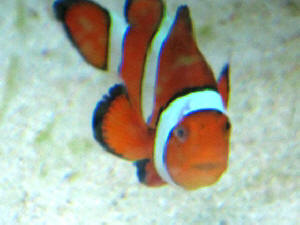
|
|
Bubble on the eye clowns from birth
1/16/12
Hello, I have two tank raised onyx clownfish. They don't look
like the other onyx clownfish that came from the same
breeder.
<Mmm, some "lines" of such sports aren't well
"fixed"; don't breed true>
I've had them for 9 months and they both have always had this
bubble on their left eye. I noticed one is getting much bigger
and much worse and has what appears to be red behind it. This I
believe is the female as it is starting to become the larger of
the two. I'm not sure what to do, if anything for these
fish.
I've attached pictures for your opinion.
http://smg.photobucket.com/albums/v637/Mickis125/?action=view
<http://smg.photobucket.com/albums/v637/Mickis125/?action=view¤t=RussellTankwithLEDlighting2011040.jpg>
¤t=RussellTankwithLEDlighting2011040.jpg
<Sorry; can't open these links as they're posted.
However, such defects as "bubbles in/on eyes are not
uncommon... could be genetic anomalies (heritable
characteristics) or evidence of emphysematosis (air bubble
disease) from exposure to super-saturated gas conditions when
younger, or something else. At this juncture/time, there is
nothing that can be done to correct it.
Bob Fenner>
Thank you so much for your time,
Mary Brelsford
Re: Bubble on the eye clowns from birth 1/16/12
Thank you for your response-I'm sorry the other links
didn't work. I'm hoping these attachments will be
viewable.
Mary Brelsford
<9.6 megs... They are... and curious. I can't tell what
the root cause is here... genetic, damage, parasitic/infectious.
This degree of debility is almost never recoverable. I would
euthanize these fish; read here: http://www.wetwebmedia.com/euthanasia.htm
And our coverage on eye conditions in marines: http://www.wetwebmedia.com/Popeyefaq2.htm
and the linked files above. Bob Fenner>
|
|
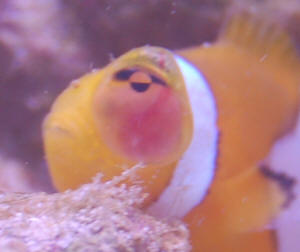 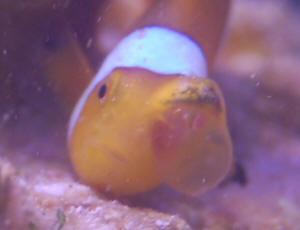
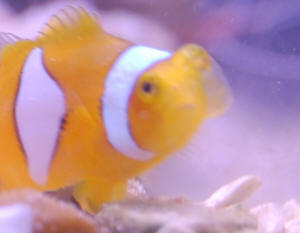
|
Re: Bubble on the eye clowns from birth
1/16/12
Thank you for your response. These fish have been like this since
birth around 9 months or so.
<...? Ago?>
Due to this, I doubt it would be parasite related.
<Mmm, actually... there are a few varieties...>
They seem to eat like any other fish and seem to be ok
otherwise.
Personally, I don't see a need to euthanize these fish, unless
I am missing a point somewhere?
<IF I believed/felt they were suffering...>
Thank you again for your time,
Mary Brelsford
<Welcome. B> |
Ocellaris Clown Treatment
12/30/11
Hello WWM crew!
I would like to get your opinion on a treatment that I have planned out
for an ocellaris clown that I bought in late October. I've had this
fish in quarantine with another ocellaris clown (both tank-raised) and
a six line wrasse (Marine Aquarium Council certified).
<Mmm, more important than this stamp is the fact that ALL such
organisms come through Quality Marine...>
Theoretically, the two clownfish should not have any parasites, since
they were bought from ORA and I put them directly from the shipping bag
into the quarantine tank that I had set up after a year of being dry.
The six line wrasse was being quarantined in another setup (because it
was wild caught and may have had parasites) and all quarantine/cleaning
equipment was kept separate between the two setups. Here is what I did
during quarantine up to this point:
1) Have two quarantine containers for each setup (one pair for clowns,
one pair for wrasse). Switch holding containers for each setup every
two days, letting the empty one dry out completely after being soaked
in hot, fresh, chlorinated water. This was done for 4 weeks for the
wrasse and 3 weeks for the two clownfish. My thought here was that this
process would eliminate Ich without using chemicals, since it has to
encyst somewhere in the container while reproducing (and would thus be
removed and killed while the fish were in the other container).
<Ok>
2) After observing no signs of disease on any of the three fish during
this treatment, I put all three together in a new ten gallon tank setup
(each fish is about an inch long right now). All was well for about a
week and a half. Then a few white bumps appeared on each clownfish
(none on the wrasse).
<"White bumps" could be many things...
non-pathogenic>
The clownfish were scratching a little bit on the rocks as well. I gave
each fish a 5 minute freshwater dip, lowered the salinity in the tank
to 1.010, and added 200mg of Metronidazole to the ten gallons of water.
Two days later, I did a 25% water change and added another 200mg of
Metronidazole. I repeated this process for 14 days. I gave the fish
another freshwater dip on day 7. The spots were gone at this point
(they disappeared about a week into the treatment).
<Then not Protozoal; too delayed response>
3) I have kept the fish in water with a salinity of 1.010 up to this
point (about 3 weeks now). About a week ago, one clownfish started
expelling stringy white waste and scratching a little bit on the bottom
of the tank.
She (I say she because she is the dominant of the two) is actively
eating, swimming around the tank, and shows typical behavior towards
the other fish in the tank. I'm concerned about her because she
spends some time laying (sometimes on her side) on the bottom of the
tank.
<Not atypical "clown" behavior for being kept
solitarily>
She seems a bit lethargic, but then she peps up when I come over to the
tank. I also found a couple of small white spots on her today, she
still twitches some, and she still has stringy white waste.
<Again, not necessarily indicative of parasitic disease>
My thought is that I'll treat her with Metronidazole via her food
for 3 feedings.
<I would NOT repeatedly treat w/ Metronidazole/Flagyl for reasons
posted on WWM and to my knowledge, all modern fish pathology works. Too
debilitating, hard on their nephros... Already treated>
If the symptoms don't go away permanently, I'll gradually
increase the salinity in the tank and, once it is back to normal,
I'll add CopperSafe.
<... and I would NOT treat Amphiprionines w/ Copper...>
I prefer to refrain from using medications, but I don't want to
lose this fish!
<You're more likely to kill them by treating them as you
intend>
What do you think is causing these symptoms?
<Mostly the (generic) "stress">
I think it's odd that the submissive clownfish shows no signs of
illness... Perhaps whatever is infecting the dominant one is internal
and, as soon as it is expelled in her waste, it dies in the low
salinity water?
Do you think this treatment plan is the best option? Also, it is my
understanding that CopperSafe should not be added to water that is not
at the salinity of seawater. Is this correct?
<No, no, and not as much>
Thank you so much for your advice! Brielle
<I would not treat these fishes further. Would move them to
permanent quarters, enjoy them. Bob Fenner>
Re: Ocellaris Clown Treatment 12/30/11
Thank you so much for your advice, Bob! It is greatly appreciated and I
will not treat them any more. Have a wonderful day!
-Brielle
<And you my friend. BobF>
|
Fish disease diagnosis troubles, Clown beat, bullied,
poisoned and crowded... 12/11/11
Howdy Crew!
After nearly a decade of reefing, I've spent many hours
reading and learning from the site, and for that I thank you
first. However, I've reached a dead end my attempt to
diagnose my troubled O. clown. He's about 1.25" long,
been with us for several months, comes from a standard
15L reef tank with 5g sump, and is not currently hosting.
Tank mates include three 1-1.25" damsels (blue, Talbot,
scissor tail) and 1.25" maroon clown.
<Some tension here; particularly w/ from the
Premnas>
No aggression issues to note, and eat like pigs. Water parameters
are near "perfect" (1.026 SG, 79.1-79.6F (ReefKeeper),
pH 8.1-8.3, nitrates and phosphates are zero). I'm feeding
Rod's complete reef food and/or brine every day and exporting
nutrients via 10% water changes & filter cleanings twice per
week. Filtration includes filter sock, skimmer and Chemi-pure
Elite.
<The carbon here may be an issue>
Recently my clown began keeping his swimming activities to the
bottom in one location against the current, and two days later
only with his nose against the glass and even threatening to stop
moving minus very labored breathing. Progression was over 4-5
days. Since the day he'd come home he'd always had a
handful of visible black spots that I had dismissed as
'normal' (or so I've read) given his healthy
behavior, but now one large spot behind his pectoral fin had
reached nearly 1/8". I'd begun to believe this may be
Paravortex despite the size and prepared a freshwater dip.
<It may be... a skin scraping/microscopic analysis would be
definitive...>
Two dips over 24hrs showed no improvement, and he was quarantined
in a large plastic coffee container kept warm in the sump. A run
to the store provided some Quick Cure,
<Yikes... too toxic>
and 12 hours later he'd come around 180 degrees!
I've continued treatment over 3 days, dosing once daily per
the directions in a 2.5g QT with just a heater and air stone;
water changes are 50% every other day.
<Mmm, have you tried an Anthelminthic?>
His eating and behavior says he's healthy and I've
diagnosed correctly.
The large spot has shrunk somewhat, but the markings have stayed
overall, which disagrees with my diagnosis. Perhaps parasite
damage, and not the actual parasite?
<Maybe>
Doesn't appear to be textbook Brooklynellosis, but fits the
resistance to FW dips and apparent death by formalin. It fits the
description of a bacteria, but not the remedy or immediate
response to the Quick Cure. Moving on to bacteria or fungus, and
the cure becomes more complicated (gram negative, gram
positive...wait...what??).
<None of these>
I can't find a description or image of this exact ailment, so
I don't want to put him back in the display and assume
he's fine. I have Methylene blue waiting in the wings and
willing to move to Maracyn or food soaked with antibiotics, but I
hate to treat aimlessly. I've attached three hi-res shots of
each side, and the best I could get of the spot behind his
pectoral fin.
Any help you can offer is greatly appreciated, and thank you for
your time!
Respectfully,
Michael
Walled Lake, MI
<I might try a course of Praziquantel... but really, these
fishes need a much larger system. Bob Fenner>
|
|
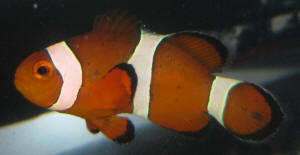 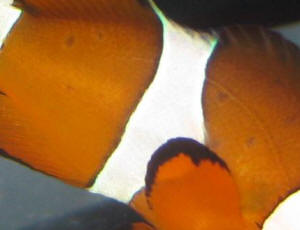
|
|
Clownfish White discoloration of face
10/6/11
Hi I have had my 2 clown fish for over 2 years now.. They host an
anemone and they are very happy.
To this day they are eating well, swimming well, are still social
with me when I put my face to the tank.
But they both developed a white patch (not raised at all, just
discolored)
each on their face. I need help I have just spent hours on the
internet looking for what this could be. (I read through all your
disease articles and clownfish articles)
<Mmm, have spiffed up, examined the pic closely. This looks
very much like a "burn" from some sort of
chemical/physical interaction... Likely a not-friendly
Cnidarian>
New additions are 4 crabs to my sump to try and clean up some
algae, New lighting (2x 250watt halides and actinics) which is
MUCH brighter than my previous lighting) We re-arranged the rock
work to allow for more swimming room for my Yellow tang.
Tank Specs
90 gallon
33 gallon sump
over 120 lbs of live rock
Ammonia 0
Nitrates <10 (I suspect due to rearranging rocks)
Calcium 420
DKH 8
Magnesium 1500
<A little high in respect to Ca conc.>
Salinity 1.024
Temp 81
Tank mates: Yellow Tang (3 months)
Hippo Tang (about 9 months)
Lawnmower Blenny (2 years)
Sand sifting Goby (1 month)
Sand sifting star (2 years)
Sand Dollar (2 years)
brittle star (1.5 years)
None of my other fish have any spots at all
I have notices that their anemone has been moving her location
(since our new lights) and the clowns have been digging up the
sand a bit.
<Of what you list, the anemone is the chief suspect... though
there might very well be other life on the rock...>
I have attached a photo.
Thanks for your reply
Brandee
<Watch their behavior carefully... are they "really
friends" w/ the Actinarian host? Do they spend an inordinate
period of time rubbing their faces against the rock?
Bob Fenner>
|
|
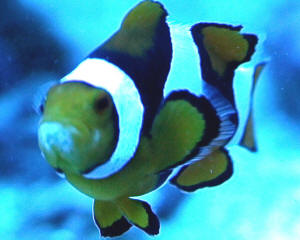
|
Re: Clownfish White discoloration of
face 10/6/11
Thank you so much for the reply.
<Welcome>
I have a much clearer picture for you. I took it today with the
halides on.
Could it be they were lip locked? fighting perhaps? I ask because 1
clown has white on upper 'lip' and one has white on lower
'lip'?
<Good question, and another (though more remote) possibility. I
see in your new pic that the host is a badly bleached Heteractis
crispa... It being stressed might very well be a contributing
factor here. Do please see WWM re the health of this anemone
species>
So you say the anemone is the chief suspect.. If he were in fact
'burning or stinging' the clowns wouldn't they stay
away?
<No; unfortunately... please learn to/use the search tool,
indices on WWM>
The clowns seem to love the anemone so much, they feed him and
don't let anyone near him. I have not seen them rubbing up on
anything at all.. They dug around in the sand for a bit after our
rock reorganizing. (nitrates are back to 0 after a water change)
and a few days of heavy skimming.
What is a good lever for my magnesium to be at?
<... See WWM re... a ration of about 1:3... BobF> |
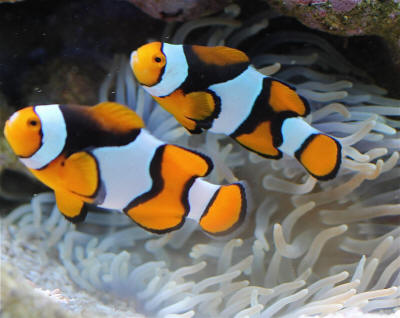 |
sick clown fish 9/22/11
Please advise... I have a sick maroon clownfish that is several years
old.
She ate fine last night, this a.m . I noticed she was laying on sand
bed under rock and not interested in coming out. My LFS is closed
today, if not I would have taken her their to hospital tank. I want to
take her out of tank because others are starting to pick at her. Will
she be ok in a 5 gal bucket w/ aerator and tanks water until
morning?
<Better in a floating plastic colander in the tank itself>
I just did a water change Sat. I have a 125gal. There are 2 skunk
clowns and a coral beauty also in tank I have just acquired a very
small Cortez ray
<Mmm, not compatible. This is actually a "cool" water
species; not tropical>
and I have some coral. I tested water and 0 ammonia and nitrite, about
10 nitrate ph is 8.4 w/ lights off.
Thanks for any help.. Eileen
<I do hope your Maroon recovers. Bob Fenner>
|
Clarkii clownfish 9/10/11
Crew:
<James>
I have looked through your FAQ's about clownfish and I am not
able to diagnose what is wrong with this Clarkii. It is about
3" long and I have had it for about 3 years. A few weeks ago
I noticed a white raised dot on its operculum. I was not too
concerned, but now it is much larger, and another area also on
the operculum, appears "blotchy". I have attached the
best photo I could get of the affected area. All parameters are
excellent and the fish behaves normal. I would appreciate any
assistance.
<I've seen such quite a few times... never demonstrated to
be pathogenic...
Likely best to consider as some sort of "pimple"...
I'd leave alone. Bob Fenner>
|
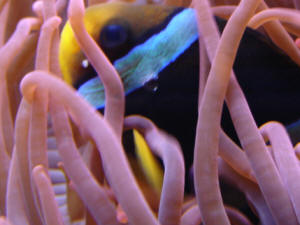
re: Clarkii clownfish
9/11/11
Thanks for your advice. It turns out the clownfish went to a
cleaner shrimp repeatedly and the following morning it was
gone.
<Ah, good. Cheers, BobF>
|
Clownfish with PopEye and acting
differently... No reading 7/9/11
Hi,
I have two tank raised clownfish (there was no description of the
breed)
<Easy enough to identify. Please read here: http://wetwebmedia.com/clownfis.htm
and I have had them together for a while, at least 12 months I think it
has been.
One is orange and the other is black. My other tank was smaller and the
black fish which was newer ate the orange fishes tail fin but
doesn't anymore.
The tank is still small at 30 litres
<Too small for these fish>
with only live rock, a coral which is barely living
<?... for what reasons? Which species?>
and some plastic plant which I put in a few months ago to increase the
colour.
The black clownfish's right eye is now slightly larger and kind of
white and it is hovering around the bottom and tries to eat but it is
like it couldn't be bothered when it gets close enough.
Is this a disease and could it be contagious?
Thanks, Courtney.
<Read here: http://wetwebmedia.com/clnfshdisart.htm
and the linked files above. Bob Fenner>
Black Ocellaris Clown... not fdg.,
ill... from? 7/7/11
Dear Crew,
I really love your website and the wealth of accurate information it
provides. I have a Black tank raised Ocellaris clown that has not been
eating for around a week. The single time I witnessed it defecating the
feces were long, stringy, and white like a worm.
<Mmm, sometimes indicative of parasitic involvement...>
The clown had not been properly acclimated (Its bag toppled over in the
water while it was acclimating)
but the temperature was the same if not the PH and salinity. I have
tried marine flakes, frozen foods of different kinds, and live brine
shrimp. It takes no notice of the food at all.
<What other livestock are present?>
No other symptoms are apparent. I have tried epson <Epsom, not the
printer> salt which has so far had no effect on the fish. If this is
a protozoic affliction what treatment regiment should I use?
<Metronidazole and an Anthelminthic. Read here: http://wetwebmedia.com/clnfshdisart.htm
and here: http://wetwebmedia.com/ClnWormDisF.htm
It says in a couple of the SW books I have to feed food soaked in
tetracycline, but the fish is not eating.
Tank Stats
Cycled
1 year old ( Used to be quarantine for a bigger, now torn down,
tank)
10 gallon
<Mmm, small>
1.021 salinity (Measured by Hydrometer)
<Too low... raise to 1.025-6. See WWM re spg.>
0 nitrite
0 ammonia
Aqua clear 50 with a sponge and some LR bits
Bak Pak protein skimmer run intermittently
<I'd run continuously>
weekly water changes of 10%
<And change more of this small volume out. Bob Fenner>
Re: Black Ocellaris Clown 7/8/11
Thanks you very much,
The clown is the sole inhabitant of the tank except for a clean up crew
(brittle star, hermit crabs, some bristle worms)
He/she is only a inch long and I do plan to upgrade to a 20 gallon once
the clown grows.
<Ah, good>
I have a couple more questions, what do you think of feeding via the
water (adding dextrose the water) until I can get the needed
medications (Not sure my lfs will carry these)?
<Not advised>
And what about a hyposalinity treatment at around 1.012 for three
weeks?
<Also>
These were the other recommendations I got when brain picking at lfs/
forums.
Thanks Again
<Read where you've been referred. B>
-Jacob
Clownfish floating on sides not breathing
4/27/2011
Hi,
<<Welcome to WWM Hayley>>
I've just got a quick question,
<<Okay>>
we just purchased 2 Clown fish and since we put them in our tank they
have floated on their sides at the bottom of the tank.
<<Labored breathing? Moving at all?>>
Just wondering is there any reason for this or is this just what they
normally do?
<<Sounds as if something environmental are affecting these fish,
likely weren't acclimated properly to begin with. Please start
reading (here are a few separate but important links); http://www.wetwebmedia.com/acclimat.htm
; http://www.wetwebmedia.com/clownfis.htm
; http://www.wetwebmedia.com/watrqualmar.htm
http://www.wetwebmedia.com/QuarMarFishes.htm;
http://www.advancedaquarist.com/2006/1/aafeature2
>>
Thanks,
<<Anytime and good luck.>>
Hayley Matthews
<<Adam J.>>
|
Skunk clown with hemorrhoid
Good evening,
Silly question but fish can't get hemorrhoids right?
<Something similar... in this case a prolapsed
"colon">
My skunk clown is in quarantine and being treated for Ick with
hypo. Kind of gross but its but is protruding from its body and
looks like a big blister. Do you know what this? Hope you can see
from the picture.
<These cases generally re/solve themselves in time on their
own. Just good care and nutrition. Bob Fenner>
Thanks,
Eric
|
|
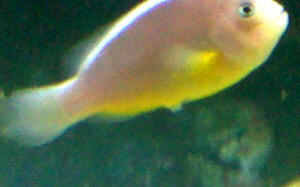
|
|
Brooklynella? Plus 12/19/10
Good morning!
<Joan>
I think my fish has Brooklynella but he has a symptom that I
don't read as connected to this disease. His scales on his
head seem to be peeling! Hope my photos are not too big (I
don't know how to resize them)
<Easily done... you could use your search tool, investigate
what software for images you have on your machine/s>
Got two wild-caught clowns on 12/10.
<Yikes... am sure you know that captive-produced are superior
in several respects>
Both were fine and swimming and eating actively for a few days.
Then one got a pinkish looking spot on both sides of his head on
his front white line. It really looked like his scales were
peeling. He was put into a hospital tank and later died. The
other one who was still in QT then contracted the same thing.
Both developed a cottony type of slime on their sides. Neither
was really breathing heavily or labored. I re-set up the hospital
tank (after cleaning) and he has been in there since last
Tuesday, 12/14. Not really knowing what this was started treating
with Paraguard daily.
<A good product, though I think this trouble is more than
parasitic... Such bad stress, impugned immunity that bacteria are
decomposing this fish>
The white slime resolved itself quickly and is gone within about
a one day treatment of Paraguard. As you can see in the photos
the fish is still alive (slowly getting his bright color back on
the front, but his rear half is still slightly faded but he never
really lost his color) but it still looks like his scales are
peeling on top of his head. He seems to be active and swims
around his tank; eats a little. What is this?
<Bacterial... Please read here: http://wetwebmedia.com/clnfshdisart.htm
and the linked files above where you lead yourself>
I am treating with Paraguard as this is all I have. I have no LFS
where I live for over 200 miles (I live in rural Montana) so
everything I get has to be purchased online (and then either wait
5+ days for delivery or spend $28 for overnight shipping for an
$18 fish what to do?).
<Mmmm>
What should I get to get this cured or should I just keep using
the Paraguard?
<The latter... It's really up to this fish at this point,
whether it will rally or no>
The other fish I got with this order a Humu Trigger, Tribal
Blenny and a cleaner shrimp have no signs of disease and they
were in the same QT with the clowns. Could these other fish have
caught this disease and it is just dormant in them and show up
eventually in my display tank months down the line?
<Not really. Clownfishes from the wild are
"uber-stressed" in the process of being removed from
their always present symbiotic anemone, being held sans food for
days... shipping damage period. They're far more likely to
failing health issues than most other fish groups. Bob
Fenner>
Joan
|
|
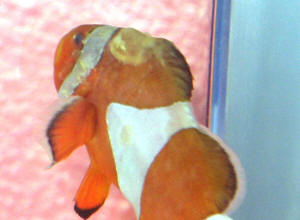 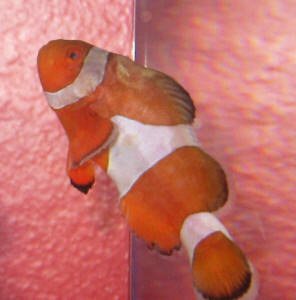
|
Clownfish, Ich, Quarantine, and not
eating... 12/16/10
Hi Crew! I have a few questions concerning the recent quarantine of a
clownfish with a mild case of Ich. Yesterday, I decided to move him to
a 10 gallon quarantine tank
<For what reason/s? Are there other fishes in the infested
tank?>
with a bio-wheel filter, powerhead for circulation, couple of pieces of
live rock, and water from my display tank. Parameters are nitrate
approx. 10, no nitrites, no ammonia, pH is a little low at 7.8.
<Actually, this is a base ten log... 7.8 is dangerously low>
Temperature is steady at 80 F. Before transferring him yesterday he ate
3 small food pellets soaked in Selcon. I transferred him to the QT and
kept lights off until offering him a small amount of food which I knew
he wouldn't accept, but I thought, what the heck. I then turned the
lights off for the night to let him calm down.
Upon checking on him today, he is acting fine other than swimming along
the bottom of the tank frequently (which I painted a dark color) as if
he were looking at something, and mildly pacing the tank. Not what I
would consider swimming erratically, but it may be to more experienced
people such as yourselves. His respiration is somewhat fast, but he is
swimming a good bit (not "darting" however). He acts relaxed
part of the time, and "checking things out" the rest. He has
been in QT for 26 hours as of writing this, and it has been just as
long since he ate anything. An important detail that I forgot is that I
am treating with Seachem Paraguard.
<With the live rock present?>
Upon trying to feed him after 24 hours of no food, he takes the frozen
brine in and then spits it out. This was his favorite food of in the
display. Any insight on when I should start worrying about his feeding,
and what I should do if that time comes?
<The move, disease... stress>
Another important tidbit is that I separated him from an anemone that
he has hosted for about 5 years. Could this play part in his anxiety
and hunger strike?
<Definitely so. In the wild, there are NO Clownfishes found w/o
anemone hosts>
Any help you all can provide is greatly appreciated.
Thanks so much, and Merry Christmas!
Heath
<And you, Bob Fenner>
Re: Clownfish, Ich, Quarantine, and not eating... -
12/16/10
Hi Bob,
<Heath>
Thanks for the speedy reply. To answer your questions, The fish is
being treated for a mild case of Ich. Also, Seachem told me that the
live rock would be ok in the QT
<Mmm, I disagree>
and any absorbtion would be small and not enough to effect the
treatment.
<They (SeaChem) have evidently removed the MSDS for this product but
an excerpt:
"ParaGuard[NFPA 1,0,1]: Principal ingredient is glutaraldehyde
with ameliorating ingredients, pH 7.
ParaGuard also contains malachite green. Malachite green is a possible
carcinogen. Ingestion may cause severe gastric disturbance. May cause
moderate irritation of mouth. If ingested, drink large quantities of
milk or water. Universal antidote (charcoal) is useful. If enough is
swallowed to cause distress, seek medical attention. Eye contact will
cause severe irritation. Flush eyes copiously with water. Seek medical
attention."
... I would NOT put Gluteraldehyde nor Malachite Green in with
"reef life"... It will assuredly mal-affect the live
rock>
I have a few more questions now, how long do I have before it is
dangerous for the fish to not eat?
<Days, perhaps a couple weeks>
Should I transfer him back to the display to get him to eat if he
doesn't eat after the time you suggest?
<Up to you... this is posted on/in WWM>
What is a safe way to get my pH up in a QT?
<Also...>
Is it safe to use a small amount of Seachem reef buffer?
<... can...pre-mixed...>
I was scheduled to do a water change in the QT this weekend for
husbandry reasons. Would a silk plant possibly serve as a surrogate for
the anemone since he has hosted other things in the past?
<Not really>
Sorry for all of the questions, I am just trying to be a good steward
of the pet that I have.
<Understood/stand>
Thanks again,
Heath
<It might do you good to read here: http://wetwebmedia.com/clndiscrypt.htm
and peruse the linked files above. BobF>
Possible disease
11/20/10
I have noticed my large Bicinctus female clown
has small grayish spots on her body (not very numerous
may I add). She has had them for a few days now.
She has been through Ick before but this looks more like velvet. There
has been a recent addition of a flame angel over the last few weeks but
this has had little incident.
<Was this last quarantined, dipped/bathed?>
However I am asking your opinion as the male counterpart of the pair
shows no sign of this. She feeds and shows no sign of distress or heavy
breathing at-all.
More confusingly she shows no sign of scratching either. I have upped
the ozone dose into my main display to see if this helps at all.
Any ideas at all?
Jim
<... perhaps stress coloration. You might benefit from perusing
here:
http://wetwebmedia.com/clnfshdisart.htm
and the linked files above. Bob Fenner>
Re: Possible disease, Clown 11/20/10
Thanks for your expedient reply. Yes the angel was quarantined prior to
addition (for 4 weeks).
<Ah, good>
Stress coloration does look likely. There are a few colonies of
Aiptasia in the tank so whether these have stung her. She certainly
doesn't show the signs of brook or Oodinium here at all.
Thanks
<Else both clowns would show... Bicinctus IS a very tough species.
BobF>
Re: Possible disease... was clnfsh... 11/24/10
Thanks for your information Mr Fenner. I have concluded this is a
stress outbreak of ICH, (the flame angel shows a tiny dusting of spots
on his tail).
<Stress is almost always a determinant factor...>
Although minor in my main display tank I am now upping ozone as
before.
Plus as I can't quarantine all fish (the QT is currently occupied
by a hippo tang). I was wondering whether a 1 off 1% Metronidazole
soaked feed along with the ozone would help the clown get on the right
side of this minor outbreak?
<Possibly... at least will help, not hurt>
She has been like this before and always pulled through this.
Is a 1 off treatment enough or should I repeat once a week?
<I'd try the once... not a good idea to repeatedly administer
Metronidazole... is very hard on fish's kidneys/nephros>
I know you should be careful with this powerful drug (I have purchased
fish zole).
Your thoughts please
Jim
<There they are Jim. BobF>
|
Clownfish disease 11/10/10
Good Evening
<Good morrow Eric>
I am hoping you can assist with a problem that I have. I recently
adopted a ocellaris clown and a skunk clown from a fellow reefers
who can no longer tank care of them. Both of the fish were just
recently added to my 90 gallon reef after a roughly 2 month
quarantine period. The ocellaris had a large bump on his side
that did not change for weeks. I assumed it was Lympho and would
resolve on its own. Today when I got home from work the lump is
no longer there and it looks like the flesh is missing. Does
this
look like some type of aggression or some other disease I am
dealing with?
<To me... possibly the resultant/sore from a physical or
stinging encounter. In all cases, only treatable w/ time going
by>
I also have another ocellaris in the tank, but I have not noticed
any aggression. I have included a picture. The affected clownfish
is the second one in the back. You can see the white area on the
back part of the body.
<I do>
I also wanted to add the fish is swimming and breathing normally
and has a very healthy appetite. I appreciate your time in
reading.
Thanks,
Eric
<I urge (solely) patience here. Bob Fenner>
|
|
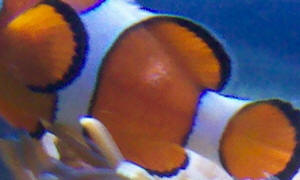
|
Re: re: Clownfish disease
11/10/10
Bula Bob
<Eric>
Did not realize you were in Fiji.
<Back last night>
I actually just returned last week from honeymoon. The diving is
incredible! I did all my diving around Taveuni and let me say the
reefs were in pristine condition.
<Glad to read, realize. Have been in the Somo Somo strait,
stayed at Garden Isle Resort. This time on the Nai'a mainly in
the Bligh Water (sound)>
The injury is starting to look a little better. The area is not as
swollen however there is another white bump on the same side which
looks more like a raised scale.
I am thinking this is from the Duncans coral.
<Could well be>
Either way I will keep an eye on things. I appreciate your response
and will let you know if things worsen.
Thanks
Eric
<And you, BobF> |
sick clowns 11/5/10
Hello Crew,
I have two sick clownfish, I think. It might be stress. That is what I
am hoping you can clarify for me. I was looking at your articles and
FAQs and would like a second opinion. I just got two tank raised black
and white ocellaris clowns.
They are my first fish in a 75 gallon fowlr that ran for over a two
months with just live rock and sand. All levels tested 0 except
nitrates which were 20-30ppm before the fish went in. I used the API
Saltwater Test Kit. The store that sold them told me it would be ok to
immediately put them in the tank since they were tank raised and the
first fish in the tank.
<Should be fine>
I drip acclimated them.
For a few days they were shy but both have eaten and seemed ok. I
checked the water and all levels were fine, except my nitrate had
spiked to 100 ppm from about 20-30.
<? From what cause/s?>
I have tried not to overfeed them. I decided to start doing frequent
water changes and cleaned all of my filtration. Last night after a
water change, I noticed that that one of them has what looks like
raised
bumps in the skin, a fat lip, and some damage to one gill. It also
looked like their may be white markings, but I think it may be a glare
off the bumps because I can only see them when the fish swims at
certain angles. I netted the fish and could not see them at all when I
pulled him close. I was worried it could be
Brook but your FAQs say that is almost a non-issue with tank
raised.
<Yes, is so... unless mixed in systems with wild-caught
Clowns>
I was ready to write it off as stress, but now the other one has been
showing clamped fins and seems to rub its belly on the rock which would
indicate the onset of ich or velvet. It also began nipping at the other
one last night, as if it wanted it to stay away. They had been staying
close up until this point. Does it sound
like I should move to QT?
<Is the water quality better there? If so, I would move them>
I have no other fish in the tank. I will continue water changes to
raise the water quality
<Mmm, there are other means... read here:
http://wetwebmedia.com/nitratesmar.htm
and the linked files above>
and be much more careful with feeding for now unless you think
otherwise. Thank you so much to whomever answers this.
Your help is truly appreciated.
Fred Grimes
<Do please keep me/us updated. Bob Fenner>
Re: sick clowns 11/5/10
Hello Bob,
<Hey Fred>
You have no idea how good it is to hear from you. Really worried here.
I got the fish from Premium Aquatics. They claim not to sell wild
caught fish if there is a tank raised version and they keep the tank
raised and wild caught on separate systems. Shouldn't be much
chance of cross contamination, but I will contact them to discuss the
situation and get their thoughts. I don't see how they could have
picked it ich or velvet in my tank, it has ran empty for over two
months. I will move the fish to a smaller QT tank tomorrow and run it
bare with a small power filter and a Cascade 300 filter that I run
empty just to get the extra water flow and aeration benefits of the
spray bar. The fish did show some small white specks, but again, it
could be light reflecting off of the raised bumps. Just hard to see
with them darting around the tank They are both still quite active and
eating. I am thinking I will prepare a freshwater dip before QT as an
extra precaution, or could this be a mistake considering they already
show signs of stress?
<All could well be "just stress". I'd hold off
dipping, manipulating these fish for now>
Thanks again for all of your help.
Fred
<Welcome. BobF, going to sleep>
Re: sick clowns 11/09/2010
Hello again Bob, Update on the clownfish situation. Spoke with one of
PAs people. They agree with you that it is stress. Got both fish into
QT and they are seem to be ok. Been feeding twice a day (too
much?).
<No, fine>
Once I do a light feeding of pellets. I give them one or two at a time
and do not give more until they are gone. The second feeding I have
given them Mysis shrimp mixed in Selcon. They seem to be doing ok
besides one showing aggression to the other. Lot of nipping, shaking,
and general harassment with no real damage done.
<No big>
They are between an 1.25" to 1.5", so it's probably
sexing off. One stays in the corner while the apparently more dominant
explores, only to come back and harass some more. I have been trying to
read up and figure try to find the cause of my nitrates. The guy at PA
thinks I may still be cycling. I had a theory about a possible cause
and was wondering what you thought. I read that does best in SPGs of
1.023-1.025. Mine is around 1.018 (based on advice from an LFS owner I
spoke to).
<I'd raise>
Could I be seeing die off on the rocks?
<Yes>
Thanks again for all the help and this website, I feel like I am on it
constantly checking different FAQs. -Fred
<Me too. B>
Re: sick clowns 11/10/10
Hello again Bob,
To update you on the fish, the larger one is looking in excellent
health now, but the slightly smaller one is suffering because of it.
The larger one has become relentless. They started out fine together.
They swam together stayed together and showed no sign of problems.
Maybe the sudden drop in water conditions caused them to go crazy. The
smaller one has become reclusive, barely eats, and is usually relegated
to a small corner of the tank. It seems to be hiding, but the other one
comes and nips on it, seems to slap it with its tail, and then settles
in front as if it is beckoning the other one to follow. I have been
pouring over the FAQs looking for answers. My best guess is that the
larger one is trying to pair off, but the other one is just close
enough in size that it is refusing to be subjugate.
<Perhaps>
I have separated them so the smaller one can get a break to
recover.
<Good>
Its bumps have subsided and color has gotten better. I was thinking of
treating the QT with Seachem Stressguard to help heal its gill.
If it makes the recovery, can I put them back together and hope it goes
better with the fish healthy.
<Yes... early on a morning when you will be about to observe,
possibly re-separate them>
Would I be better served returning the aggressive one and trying a
significantly smaller one to form a pair?
<Not really>
If I take the second route, what are the chances of getting an orange
ocellaris to pair with the black one?
<Pretty good... better than 50%>
Thanks again for all your help. Here's hoping my next email will
find me with two healthy fish that are getting along better.
-Fred
<Ah yes. BobF>
Clownfish Gets Pale, Then
Rebounds/Clownfish Health 11/3/10
Hi crew,
<David, seems I recall you have wrote us recently.>
Back again. I have been scouring the forums and the FAQs, and have not
found a clear answer for what I am seeing. I just got my first two fish
for my aquarium, two ocellaris clowns (one black and white, one
orange). Both were bought tank raised from Premium Aquatics. I selected
two eager looking ones that came close to the front of the tank while
the others stayed back. I acclimated them directly to my main 75 gallon
tank since there were no other fish in it. All parameters have stayed
in the proper ranges with little no fluctuation since I brought them
home. The problem is that the black and white seems to get pale and
stays in one spot when the lights are off. After it notices me or I
turn the lights on, it starts swimming and the color returns. It also
has what looks like an abrasion around its gill. I didn't notice,
but pictures I went back over reveal that it was there when I purchased
it (poor selection on my part by placing too much stock in the
fish's apparent eagerness). The fish eats fine, in fact it is the
more aggressive eater of the two. The orange also seems to get pale,
although it is to much less of a degree and a little more difficult to
notice in an unlit tank. Again, when lights are on all color and
activity returns. I am feeding them Spectrum marine pellets and Mysis
shrimp. I saw a few forums that say this paling in the dark is normal,
but I am skeptical and trust you peoples' advice.
<Is normal with most marine fish, no problem here.>
Also I can't seem to get them over watching their reflections,
especially the orange (has shown signs of becoming the dominant one).
Sorry about the long very specific email, and thanks in advance.
<You're welcome. James (Salty Dog)>
-Dave
Re Clownfish Gets Pale, Then Rebounds/Clownfish Health
11/3/10
James,
<David>
Yes I did write recently. I always give the back story over again in
case the crew member that answers isn't the same one.
<Is a good idea.>
Thanks for putting my mind at ease.
<You're welcome. James (Salty Dog)>
-Dave
|
Eye problem in new clownfish
10/25/10
Dear crew -
<David>
We just got a new clownfish and when we brought it home, we
noticed that there appears to be something on its left eye.
We're trying to figure out whether this is (a) dangerous to
the clownfish itself or (b) dangerous to our tank.
<Your pic is too blurry to make out much, but it does appear
that this fish has something attached to it's eye and places
on the body... could be a Protozoan parasite... possibly Uronema,
other... Read here:
http://wetwebmedia.com/clnfshdisart.htm>
(We don't have a quarantine set up,
<Too late this time>
but the store we got it from generally is good about
quarantine
<Mmm, is this a wild-caught specimen? Appears to be... tank
bred/reared ones are vastly superior>
and he looked fine at the store.) For lack of a good description,
it looks like a thin clear film over the left eye, almost like
the translucent tube of a sponge. It definitely is not red like
the Popeye pictures on the website. There's also a purple
splotch behind the left eye.
The right eye looks absolutely normal. The fish has a really
normal coloration and is swimming normally. It appears curious,
looking around, and watching us through the glass.
We've attached a picture.
Thanks!
Dave and Laura
<Do send along a "progress" report if you would. I
do hope this "is nothing", but doubtful. Bob
Fenner>
|
|

|
True Percula clownfish anal duct sore?
9/22/10
Hello,
My female true Percula clownfish seems to have developed what appears
to be a anal duct block or sore. At first it appeared to be the initial
stages of the egg-laying routine that we typically observe.
The anal duct was open and a slight pinkish mass could be see, along
with what looked like clear vesicles. She doesn't appear to be fast
breathing, scraping or swimming erratically. She does seem to hover on
one side of the tank more than usual. She also has not been eating. She
makes the attempt, but spits out everything. The breeding pair of
clowns ( of which she is the "momma") have been in the tank
for 8 months have has an issue.
My concern is if this in an infection of some sort. The other
inhabitants in the tank appear to be fine.
<Mmm, often such cases are labeled as "prolapsed
colons"... Naught to be done really... other than perhaps adding a
modicum of Epsom Salt>
Sorry for the lack of pictures. The anal duct seems to be extremely
dilated or the sore gives appearance as such. The edges do look
somewhat frayed. The condition has been observed for 5 days now with
possible a slight improvement in overall size of the internal bulge
that terminates at the anal duct.
Tank specs:
60 gallon cube with 20 gallon sump.
T5, metal halide lighting
High flow Rio pump in sump, Hydor pump in tank, rotating pump in
tank.
Good coralline growth through out
Healthy propagating Duncans 5 heads started from one
Multiple Zoanthid colonies
2 varieties of Xenia
Healthy growing pipe organ coral
Healthy chalice coral
Clean up crew of Astrea, bumble bee snail, 3 hermits
Healthy polyps (small colony)
Several mushrooms (small)
Two very large mushrooms that continue to grow,
Star polyps
Fragged Montipora
100? Collonista snails
<Wow>
One pigmy cherub angel
One lawnmower blenny
And the mating clowns
What I have done different in last 2 weeks.
1) stupid impulse buy of Condy anemone, subsequently removed 6 days
ago. Clowns stayed away for the Condy, but it did burn some corals
<And possibly the Clown>
2) Started minimal feeding with Cyclopeeze five days ago.
<This is fine>
Any help would be greatly appreciated
Robert
<Please search WWM with the term-string: Clown Prolapsed Colon
Mmm, or see the highlighted bit here:
http://webcache.googleusercontent.com/custom?q=cache:VmRKfm0xDJAJ:www.wetweb
media.com/clnfshdisart.htm+Clown+Prolapsed+Colon&cd=6&hl=en&ct=clnk&gl=us
In case this is a biological issue.
Bob Fenner>
Re: True Percula clownfish anal duct sore? 9/27/2010
Thank you for the reply and sorry for the delay in response. I
unfortunately had to leave town for a week during this episode. The
momma is now eating and the bulge is gone and the duct closed.
<Ah good>
It appears to have healed. I appreciate your advice. Now I'm seeing
some bleaching on the chalice coral and almost complete bleaching of
the Montipora,
<?!>
One of the biggest Duncan polyps also seems to have been bleached out,
but retains its usual morphology. I did the usual testing and water
changes and will monitor closely. My wife did tell me that the large
hermit crab was harassing the other tank inhabitants and that my little
girl added a shell from her beach combing collection "to give him
a new home". I fished out the shell when I returned, as it was not
"tank ready". Hopefully this was the culprit. Otherwise
everything else appears fine. It's amazing how often disaster seems
to visit this tank while I'm away ;(
<One corollary of a/the "Murphy's Law"
doubtless>
Once again thanks for your help. It's sites like yours that keep us
from doing more harm than good.
Robert
<Welcome. BobF>
|
|

